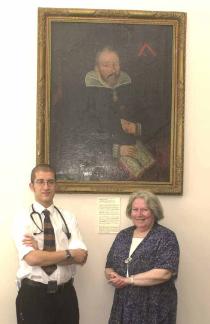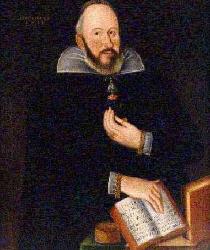Tayside Medical History Museum Art Collection - The Kinloch Portrait

The portrait of 16th century Dundee doctor David Kinloch (1560-1617) hangs in the Board Room of the Medical School at Ninewells Hospital and is the oldest painting in the University collection (dated 1614).
A painted copy of this portrait also hangs in the main ward corridor of the hospital, kindly donated by a Kinloch descendent.
Until recently, nothing was known about the time David Kinloch spent abroad other than his own words in a poem printed in 1596, stating that he had spent six years imprisoned by the Spanish Inquisition.
There was also a reference to the city of Rennes in Brittany in a birth-brieve letter for David Kinloch, written by King James VI in March 1596(97).
A legend handed down through the Kinloch family descendants suggested that he had been released from prison in Spain after curing the Grand Inquisitor of an illness.
In 1998, Laura Adam, the honorary curator of the medical history museum and Adam Yagui-Beltran, then a third year medical student from Spain, planned a research project involving a search in the archives of the Inquisition for information about David Kinloch's imprisonment.
The archives of the Inquisition are held in the Archivo Historico Nacional in Madrid, and are remarkably complete for some periods and Tribunals, so there was a chance that the search would be successful, despite the fact that all previous queries had met with the response that there was no data about David Kinloch to be found.
When Adam arrived at the archives, he was again told by the archivist that there was nothing to find. The staff in Madrid had looked themselves after previous queries and found nothing. At this stage it would have been easy to give up. However Adam persevered, since he knew from the preparatory research that there was a reference in a book written in German in 1902 to a "David Chinaloc" from Scotland in the year 1594-95 at the Tribunal of Toledo, with a catalogue number used when the archives were stored in Simancas before the First World War.
Although Madrid catalogue numbers were different, he asked to see the one manuscript which cross referenced the catalogue numbers, and the search ended with success! Adam found not only the relación de causa, the summary of David Kinloch's trial, but also several letters written by the Tribunal of Toledo to the Holy Office of the Inquisitor General in the period 1588 to 1594 about "Dr David."

Adam and Laura with the portrait

The later copy, attributed to Adam de Colone (c.1620s
but possibly later) is one of three known to exist, all of which feature various minor differences in the appearance of the subject and the props in front of him
All documents except for one Latin letter were written in Castilian. During the next three years, Adam and Laura transcribed and translated the documents and researched further where the information led. The historical interest and importance of this unique discovery of lost documents is enhanced by the fact that relatively few Scots were imprisoned by the Inquisition during the 16th century, and the information gained provides insights into the conflicts of that turbulent period of history.
The documents revealed a fascinating glimpse of the personal tribulations of a Scottish doctor coping with the religious turmoil of his age during his travels. His life abroad involved betrayal, religious conversions, romance, torture, delayed and lost correspondence, and accusations of spying. He was accused of Lutheran heresy by two Englishmen in Madrid, who had known of him in France, and Dr David's defence that he really was a true Catholic depended entirely on the people he knew in Rennes, where he had settled as a physician after graduating from the University of Medicine in Montpellier. Woven into his defence was an unexpected love-story, as he claimed that he had only pretended to be a Protestant after his conversion to Catholicism, in order to find favour with Mademoiselle de Malot in Rennes, with whom he had fallen in love. There was confirmation that he had to submit to torture on one occasion during the interrogations, and in contrast, there was surprising evidence of praise of his medical expertise and pleasant personality. The family legend relating to the Inquisitor General was not confirmed, but a wealth of information about Dr David's experiences in Spain and his life in France has been gained. The results of this study have now been published in The Innes Review. Those who come to see David Kinloch's portrait in the Medical School can now look on his face, knowing more about his life before the portrait was painted.
Medical History Museum Art Collection Index
Medical History Museum Homepage